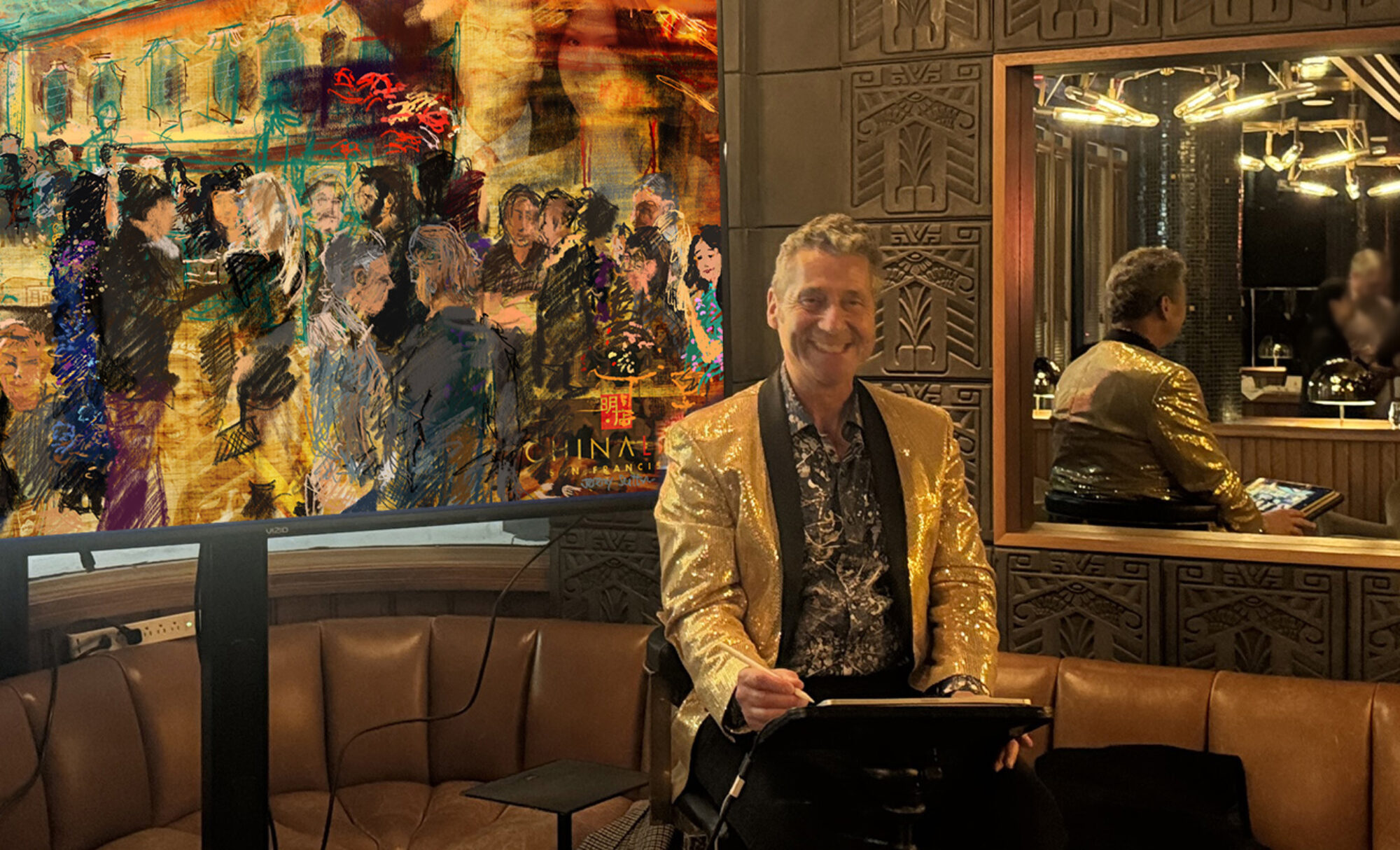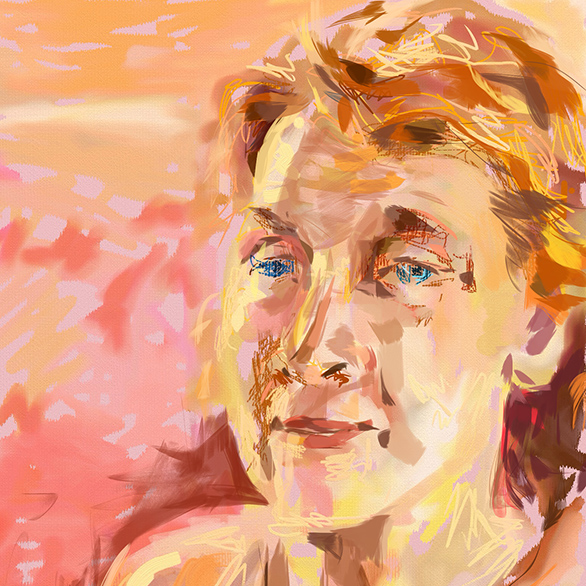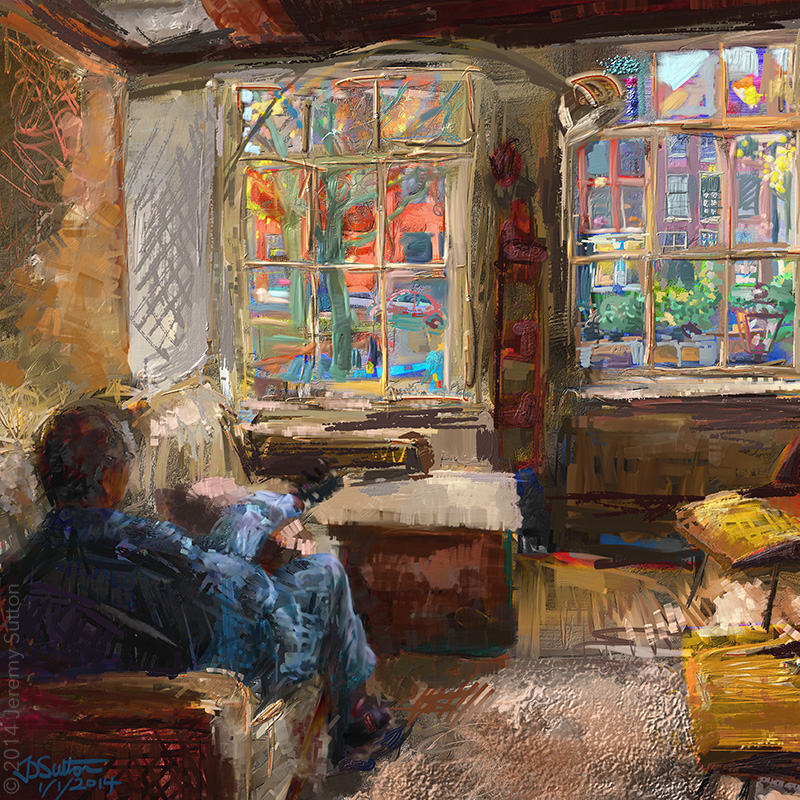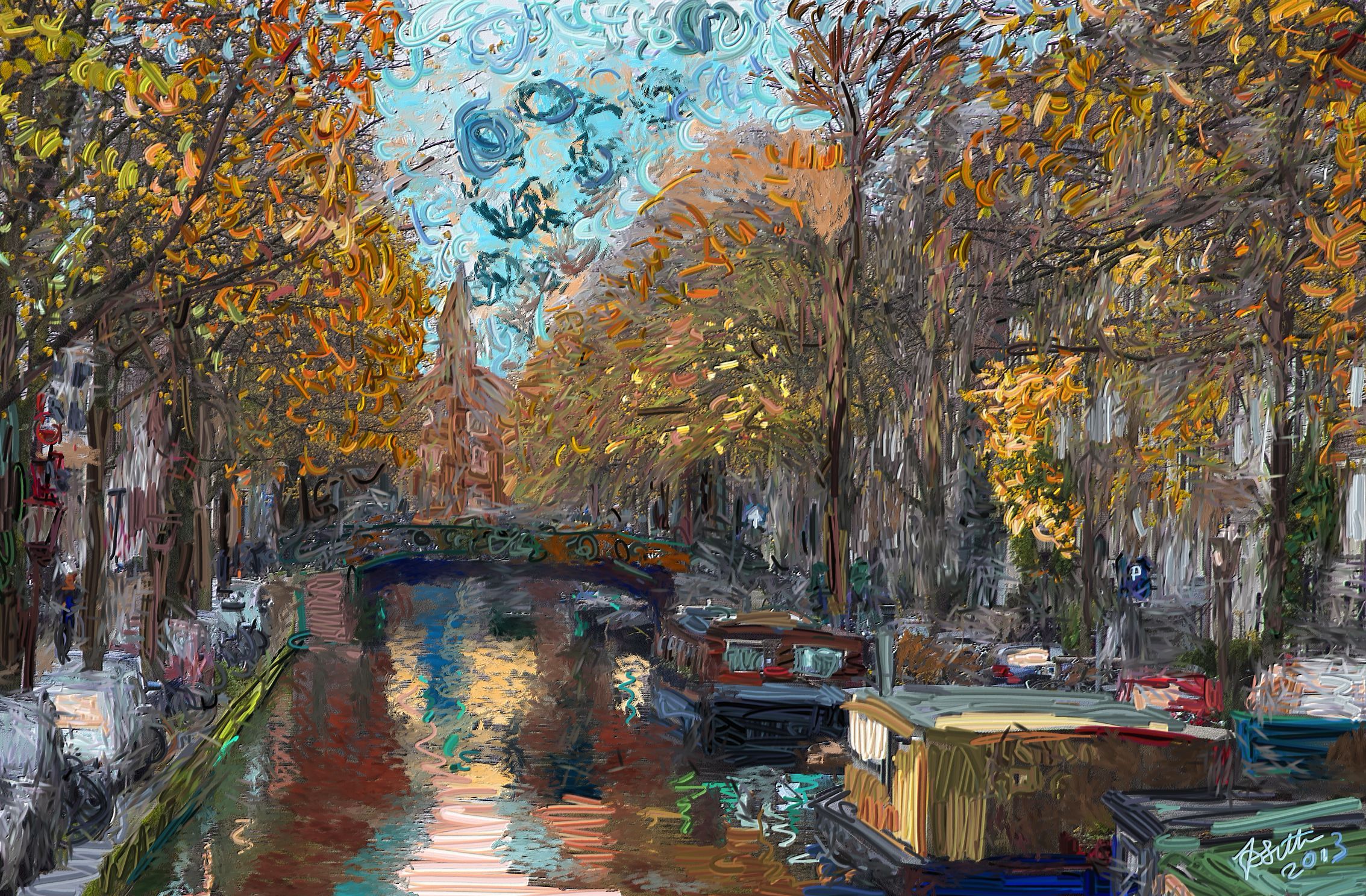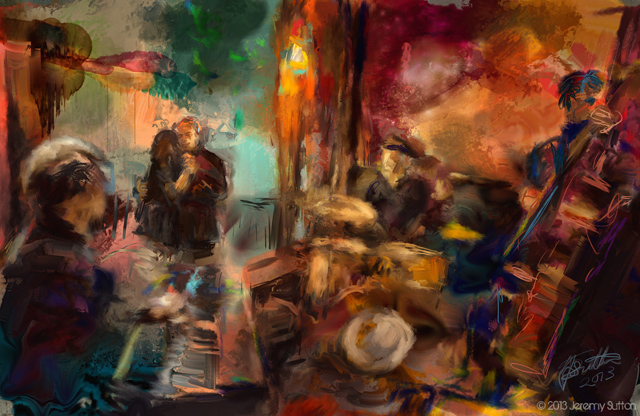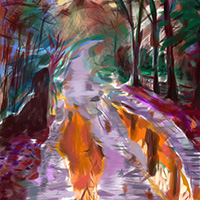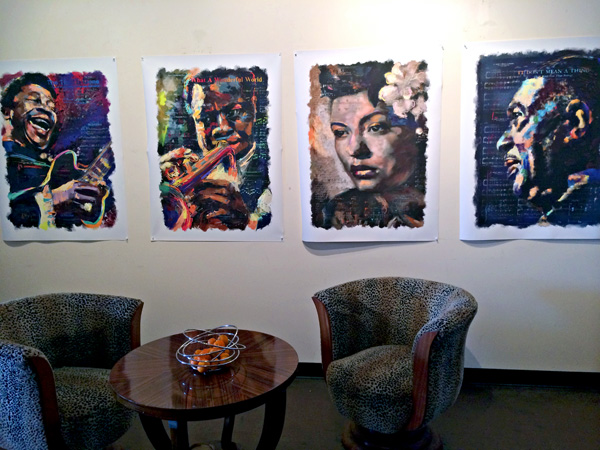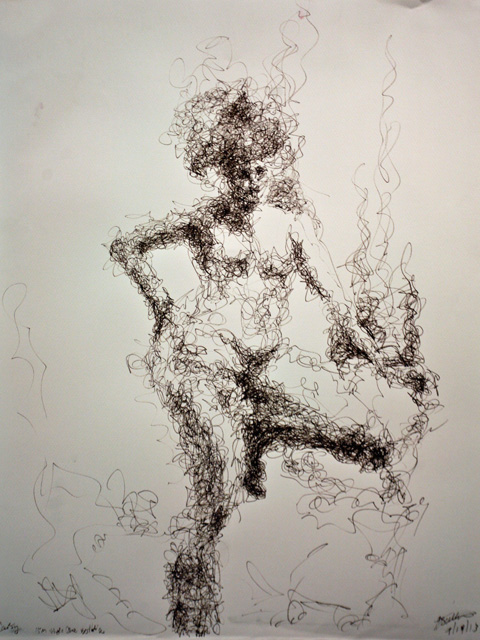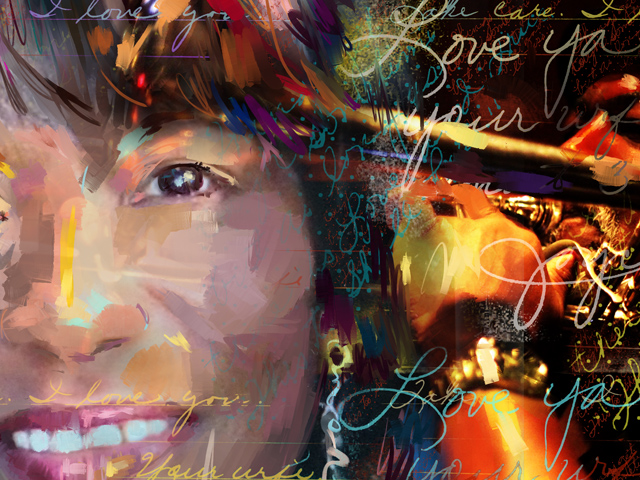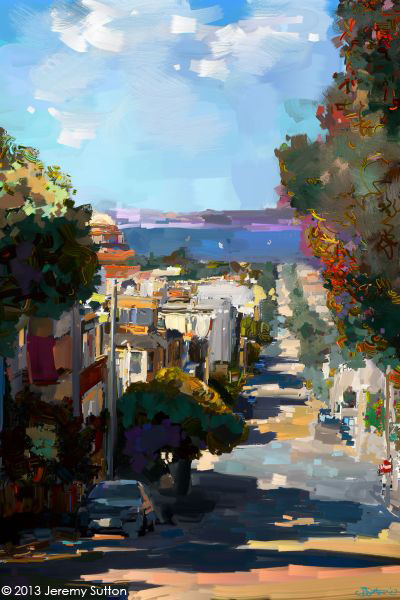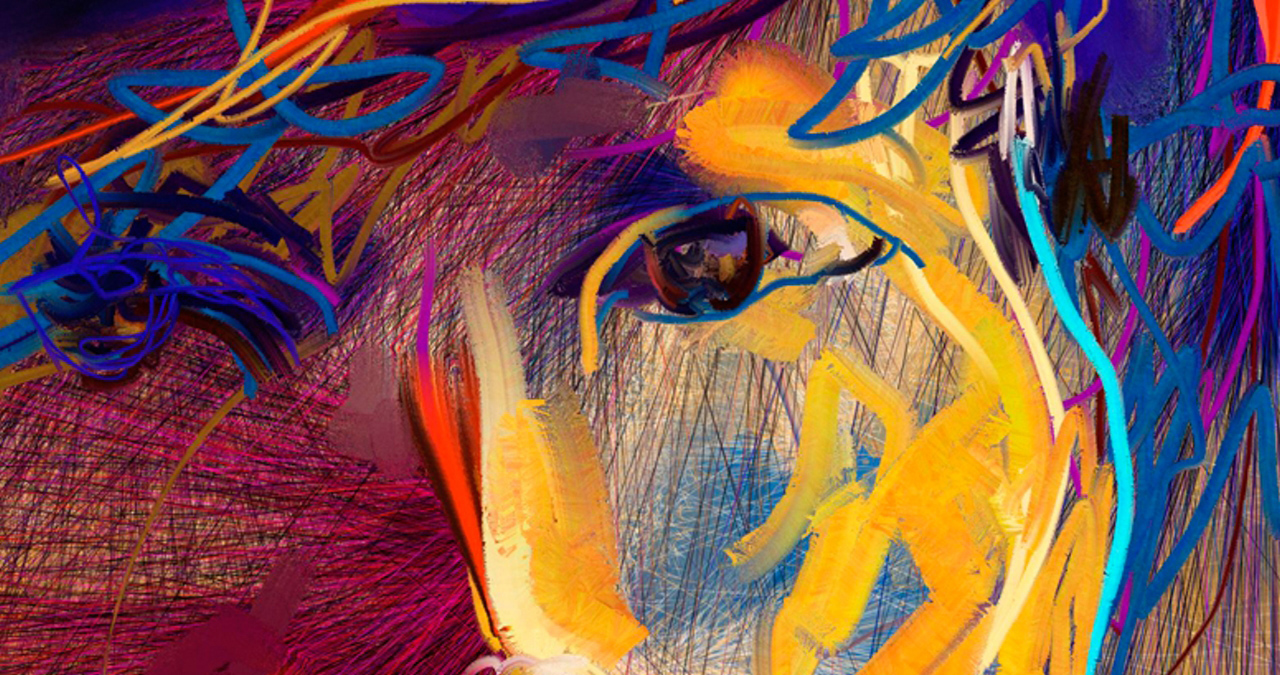
“Marge in Key West”, 2014, iPad Air + Art Rage + Pencil by 53
This sketch was created from life.
Looking Out

“Looking Out”, 2014, 24″ x 24″, pigment ink and acrylic on canvas
This painting depicts looking out on the beautiful Prinsengracht. It is inspired by my recent visit to Amsterdam where looking in and out of windows is a big thing! People in The Netherlands tend not to have the ubiquitous privacy-protecting “net curtains” I grew up with in London. Instead, as I understand the Dutch history (and any Dutch readers please correct me on this), the culture was to show one’s possessions through your windows as a means of establishing status and showing the attributes of wealth. As much as folks like to look in at windows, it is just as interesting when your room overlooks a canal, such as in the old center of Amsterdam, to look out at life going by. People walk and cycle much more in the Netherlands than in America and probably than in most other places in the world, and this activity on the streets makes looking out of a window all the more fascinating.

For those interested in media, process and technique, this painting, my first of 2014, was created entirely using Corel Painter X3 on an iMac with a Wacom Intuos5 M pen tablet. I used this painting as an exploratory playground for going through and reminding myself of all fifty Impasto brushes in Painter. The Impasto brushes are designed emulate the effect of applying thick paint on your canvas. The process of creating this painting will be the subject of this month’s video tutorial here on PaintboxTV.com.
I really enjoyed painting the scene through the window. I treated each window pane as a mini-painting and used different combinations of brushes in each.
My artistic inspirations for this painting were primarily the thick ‘impasto’ painting technique of Vincent van Gogh and the focus on pattern, shape and design of some of Henri Matisse’s work. I was also inspired by van Gogh and Matisse’s marvelous bold expressive color and use of outline, and David Hockney’s approach to widening your vantage point and getting away from one point perspective.
If you’d like to see another painting also inspired by my recent Amsterdam visit, please see “Amsterdam Canal”.
January 1, 2014
Amsterdam Canal

“Amsterdam Canal”, 2013, 40″ x 26″, pigment ink and acrylic on canvas
This painting was created as part of a tutorial titles “Thick Paint: Inspired by Van Gogh” which you’ll find in the Painter X3 In-Depth section on this site. I love the vistas in Amsterdam as you look down the canals at the bustling life where bicycles, house boats, tall houses and, at this time of the year, beautiful golden leaves, all vie for attention!
Another painting also inspired by my recent visit to Amsterdam is “Looking Out”.
December, 2013
Sublime Jazz

“Sublime Jazz”, 40″ x 26″, pigment print and acrylic on canvas, 2013
This painting was created as part of my creativeLIVE Intro to Photo Painting: A Creative Approach Using Corel Painter X3 workshop. My inspiration was a photograph (below) that I took of Gwenda and David dancing to the music of the Danny Brown Trio at Bruno’s Pizzeria Cucina on the Fillmore during the Fillmore Vintage Couture Ball. I love the way that Gwenda and David were lost in their own world as they moved to the sublime jazz… hence the title of the painting. Thanks to the Danny Brown Trio, Gwenda (of ArtAmbassador.net) and Dave for their unwitting inspiration!

Original source photo

Start of the digital painting on the set of creativeLIVE

Post-print painting on the set of creativeLIVE
November 12, 2013

David and Gwenda dancing in front of painting at the Verdi Club, San Francisco, March 2015

David, Gwenda and I in front of painting at the Verdi Club, San Francisco, March 2015
Live iPad Painting at Opening of
David Hockney: A Bigger Exhibition
de Young Museum, San Francisco

Performing live iPad portrait sketching at the opening (October 25th, 2013) of the historic and epic “David Hockney: A Bigger Exhibition”, the largest exhibition ever at the de Young Museum, and the biggest exhibition of Hockney’s art in the United States since 2005. (Photo: Stephen Somerstein)
The two iPad drawings shown above were inspired David Hockney’s work iPad drawings in the de Young show. Both these drawings were both created in the exhibition using the Sketch Club app with the Adonit Jot Touch stylus. The first one, which I spent about two hours on, was based on the replay video video showing Hockney’s process of building up a painting from start to finish. Every time I looked up I saw a different stage of the painting which made an interesting subject changing with time. Thank you Robert for kindly taking the video of me painting. By contrast the second one was created in the last ten minutes of the show, sitting in front of one of Hockney’s large scale iPad prints. The guards almost had to push me out of the gallery! The inspirations for both of these were from paintings that were part of Hockney’s ensemble of works entitled “The Arrival of Spring in Woldgate, East Yorkshire in 2011 (Twenty Eleven) Version 3, 2011-2013”.
I taught two show related iPad art workshops, “Paint on the Go! Inspired by Hockney”. The workshops drew upon ideas, themes and inspiration from the show, and included a guided tour of the Hockney show in which I highlighted the lessons we can learn from Hockney in the context of drawing and painting on your iPad. We then applied these artistic and thematic lessons to painting in the exhibition itself, much to the fascination of onlookers, as you can see from the photo below show student Henk Dawson painting in the show:

About Hockney and the “Bigger Exhibition”
It was visiting the “Bigger Picture” David Hockney exhibition at the Royal Academy in London, January 2012, and experiencing the impact of his large iPad paintings, as well as video replays of his iPad paintings, on display in such a traditional environment that kick-started my exploration in earnest of using the iPad as a serious fine art tool, after twenty years of digital painting on the iPad’s big brother, the Macintosh computer. Besides the opening of the Hockney show at the de Young Museum, I’ve subsequently performed live iPad painting at the Smithsonian American Art Museum’s America Now! Innovation in Art event; at the Seoul Museum of Art as part of their Digifun Mobile Art Festival; at the flagship Apple Stores in Regent Street, London, and in San Francisco; at the Oxford Internet Institute, Oxford University; at the SIGGRAPH Studio in Anaheim; at SEMA, the worlds largest custom car trade show in Las Vegas; as well as at other private and public events.
David Hockney is one of the greatest and most well-known living British artists. To learn more about him also see his Wikipedia entry. His work has spanned a wide range of media, subjects, styles, points of view and size. Over the years he has worked with oils and acrylics on canvas, pencil, charcoal and watercolor on paper, color xerography, photographic collage (“joiners”), polaroids, multiple camera videos, and digital painting on his computer (Quantel Paintbox, TimeArts Oasis and Adobe Photoshop with Wacom tablet), iPhone and iPad (Brushes app), including synchronized digital video replays of his iPad drawings. His subjects have ranged from the iconic Los Angeles swimming pools to portraits and figures of himself, his family and friends, as well as interiors, still life studies and landscapes. The paintings you see at the top of this page are, on the left, an iPad self-portrait of Hockney and his iPad, and on the right, a plein air iPad painting of woods in Yorkshire. His style has varied from natural color high realism to non-natural color (with a tip of the hat to Fauves like Henri Matisse). His exploration of depicting the moving and ever-changing three dimensional world in static two dimensional artworks (with the exception of his video installations) has included juxtaposing and arranging multiple images into single artworks, making series of works of the same subject over time and seasons (in the spirit of Claude Monet), and taking themes and subjects and abstracting from them in series of works (such as his series based on Claude Lorrain’s “The Sermon on the Mount” with cubist inspiration from Pablo Picasso). He has pushed the boundaries of the size of his paintings, both traditional and digital, working on larger and larger artworks, many divided up into multiple canvases on a grid system. The “Bigger Exhibition” at the de Young Museum was a historic review of the work he created over the last decade, since the completion of his book “Secret Knowledge: Rediscovering the Lost Techniques of the Old Masters”. It included huge prints of his iPad drawings and fascinating replays on screens showing his process and actual brush strokes. His example encouraged everyone to be free, take risks, look intently, draw from life and seek to express multiple vantage points in our work.
To learn more about Hockney, this exhibition and current exhibitions, please see these links:
David Hockney 25 at the Fondation Louis Vuitton, Paris.
David Hockney: Bigger & Closer (not smaller & further away) at the Lightroom, London.
Love Life: David Hockney’s Timescapes – talk by Lawrence Weschler at the de Young on October 26, 2013 – de Young Museum YouTube channel. Excellent overview talk. (video)
David Hockney 2009, A Bigger Picture – BBC presentation of Bruno Wollheim’s documentary on Hockney’s preparation for the Bigger Picture show at the Royal Academy, London. Great insights into Hockney’s working methods. Shows him in action. (trailer video)
David Hockney – Painting The Tunnel – excerpt from the bonus material that came with Wollheim’s documentary, re-edited by Anna Rusbatch. Shows the progress and process of Hockney painting a single plein air painting. (video)
Art review, Hockney at the de Young: changed views – San Francisco Chronicle
How David Hockney Became the World’s Foremost iPad Painter – Wired magazine
iPad art gains recognition in new Hockney exhibit – AP exhibition review
David Hockney — bigger, bolder, brighter, digitized – San Jose Mercury News
Artist David Hockney’s iPad and iPhone artwork goes on display at the de Young Museum – San Jose Mercury News
He’s Back, in a Defiant Blaze of Color – New York Times
iPad art gains recognition in new Hockney exhibit – Yahoo News
Pop Art Legend’s iPad Ingenuity – Associated Press (video)
Jazz Four

Series of four paintings as they were being painted in my studio, each 24″ x 36″, pigmented ink and acrylic on canvas

Framed and on the wall…
I call this series “Jazz Four”, even though strictly speaking it is “Jazz Two or Three + Blues One or Two”. The series of four portraits depicts legends Duke Ellington, Billie Holiday, Louis Armstrong and BB King. The series is being created for Dan, who selected the subjects and also the song themes for each subject: “It Don’t mean a Thing (If it Ain’t Got that Swing)” – Duke Ellington; “Strange Fruit” – Billie Holiday, “What a Wonderful World” – Louis Armstrong and “The Thrill is Gone” – BB King. In each case the words and sheet music for the song is woven into the composition. The portrait of Duke Ellington was inspired by a photograph taken by Reggie Jackson, the great uncle of my friend and amazing jazz singer, Kim Nalley, who kindly gave me permission for its use. Thank you Kim!
There is a story behind each portrait: the elegance and pride of Duke; the pain, pathos and beauty of Billie; the outer/inner conflict of Louis, playing a song about joy and yet looking pained and whilst being a State Department-sponsored Jazz Ambassador to the world facing such discrimination at home; and then BB’s unadulterated passion and joy as he sings the blues about the thrill being gone….Each one a complex tapestry of emotion that tugs at our own hearts.

October 2013
Repose: A Single Line Scribble

19 3/4″ x 25 1/2″, brown sepia Faber-Castell pen on fine art paper
This drawing is a fifteen minute single line “scribble” life study of Daisy. For the duration of this pose I kept the pen moving on the paper in a scribble manner, adjusting the density of the scribble according to the relative lightness or darkness of the value or tone I observed. This is a great loosening up exercise both for your arm and body as well as for your line itself. I drew this standing up with the paper vertical on an easel and looking between the paper and the model, never stopping the movement of my hand on the paper.

This drawing will be on display at my Fall Open Studios, Sunday, October 27 (11am – 6pm).
October 2013
Portrait of Joyce, for Danny

My good friend and super talented trombonist and singer, Danny Armstrong, asked me to create a portrait of his late wife Joyce from a photo he had. I asked him for some samples of her hand-writing to include in the painting, and he sent me images of some very touching notes she had written to him. I used all these, plus a photo I took of Danny playing at Club DeLuxe, and created this portrait. You can see Danny and I picking the framed painting up from the framers (below). Though I never got to meet Joyce in person, I felt like I got to know her a little bit during the process of painting this portrait. Danny plays with one of my favorite local swing bands, Lavay Smith and Her Red Hot Skillet Lickers. He has sat for his own portrait a couple of times. You can see one of them by clicking here.

October 2013
Looking Down Divis’
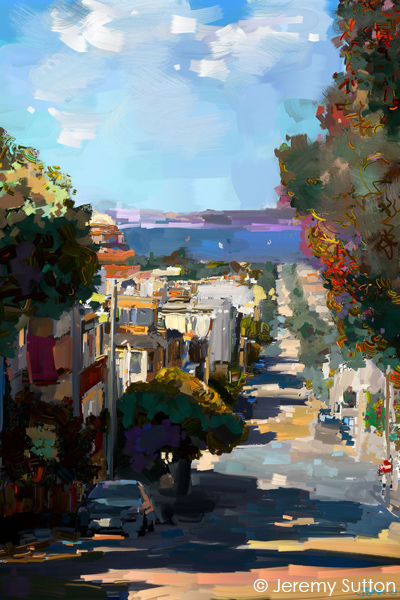
Looking Down Divis’
2013, Pigment ink on canvas
40″ x 60″
This painting depicts the magnificent view looking down on the San Francisco Bay on a sunny afternoon the top of Pacific Heights. That afternoon Peggy and I drove down to the Marina to see the last race of the America’s Cup. With traffic we ended up seeing the only the top of the sails sailing away to the finish line! In the end what was most memorable was this incredible view looking back at the Bay on the way home. The painting was created freehand using Corel Painter X3 with a Wacom Intuos Pen Tablet and a couple of new custom brushes I had just made (Trail-off Bristle Brush and Camel Hair Bristle), and manifest physically as an archival pigment ink print on canvas. Having recently walked around the wonderful Diebenkorn exhibition at the de Young Museum a few times prior to painting this, plus my admiration of Matisse and the Fauves, influenced my choice of colors and composition.
I made two versions of this painting: a taller narrower version shown below and a shorter version shown above.

Looking Down Divis’
2013, Pigment ink on canvas
44″ x 100″
This painting was displayed at my iPad painting performance at the opening of the “David Hockney: Bigger Exhibition” in the de Young Museum, October 2013


Air Painting! A Revolutionary New Way to Paint
Painting in the Air…Literally
Imagine painting in the air, literally… That is now a reality. Since 2012 I have been experimenting with, and helped shape, cutting-edge prototype air painting technologies, working closely with different hardware and software developers. One of the technologies I have explored is the amazingly powerful combination of the revolutionary new Leap Motion Controller, the world’s most accurate 3-D motion-control technology that accurately maps the movement of your hands and fingers in three dimensional space, and Corel Painter Freestyle, a simplified Leap Motion-enabled version of the phenomenal paint program Corel Painter that I have been using for over twenty years.
See the Epson video of me air painting at the SIGGRAPH conference, Anaheim, CA; the Vimeo video featured on the Leap Motion blog; my air painting presentation at the ideaCity conference, Toronto; plus the BBC article.
More recently I have been exploring air painting with other software such as Leap Motion-enabled Ethereal on the Mac platform; with a custom prototype using Kinect technology; and with the Leap Motion combined with the Oculus Rift for VR 3D air painting.
Paradigm Shift
In January 2007 I was a speaker at Macworld and had the pleasure of sitting in the hall when Steve Jobs introduced the iPhone. I see the introduction of the Leap Motion control of computers as an equally significant paradigm-shift in the way we interact with our devices. Just as kids now take touch screens for granted, in a few years they will also take motion gesture control for granted. Painting in the air has a quality of magic… a cross between being a magician, a dancer and a symphony conductor! I am reminded of Arthur C. Clarke’s Third Law: “Any sufficiently advanced technology is indistinguishable from magic.” This certainly fits the bill!
What struck me as I painted the portrait of Lisa and also the still life, both shown above and both created 100% using only movement and gesture of my hands in the air, was (1) the level of fine control of the quality of line I was able to achieve using movement in the z axis, equalling or even surpassing the level of pressure control I have using a pressure-sensitive Wacom pen tablet, and (2) how much I liked the quality of marks I made through motion in the air, and how there was a playfulness and looseness to the line quality that was different to the type of marks I would make either using a Wacom pen-tablet or traditional physical media.
On Wednesday, July 24, I gave a presentation on air painting at the world’s largest conference devoted to computer graphics, SIGGRAPH. I also presented air painting in the SIGGRAPH Studio
The Background to Air Painting with
Leap Motion and Corel Painter
I became aware of Leap Motion in May 2012 and immediately saw the potential for a new way to paint. That same day I contacted both the Corel Painter team and Leap Motion, introduced them to each other and subsequently worked closely with both companies to help shape the resulting Painter product powered by motion gesture input from the Leap Motion device. I am a named inventor on Corel’s pending patent application for controlling color selection using gestures in a vision system. In March I demonstrated painting in the air with Corel Painter Freestyle and Leap Motion in the Leap Motion Experience tent at the South by Southwest (SXSW) Interactive Media Conference, Austin, Texas, where Leap Motion officially launched their product.
Demonstrating air painting in the Leap Motion Experience, plus air painting in the air, literally, at 30,000′ on a Southwest airline plane coming back from SXSW (the first ever air painting at that altitude).
While demonstrating at SXSW I was asked if painting in the air is tiring on my arms. I painted for three full days, each day for about five or six hours, and had no problems with arm fatigue. It was my legs that got tired standing for that long! I positioned the Leap Motion controller device low enough that my arms and hands remained most of the time in what I refer to as “dance position”, that is a comfortable position with a slight bend in the elbows. Here are a few links related to the SXSW air painting demonstration:
Press Release from Corel published in ImagineFX magazine
Vine video taken at SXSW by Steve Garfield
Instagram photo taken at SXSW by Steve Garfield
More About Corel Painter Freestyle
Corel Painter Freestyle allows you to easily select brushes, textures, commands and choose hue, value and saturation, to know where your cursor is in hover mode and to finely control your entry through the painting plane, all through hand movement and gesture. I can even save my files, clear the canvas and finely control the brush stroke quality, size, opacity and movement, and then be able to easily choose from 24 million colours, all with movement in the air and without touching anything. It takes a little practice to get used to, but once you do get the hang of it and sense of where the 3D painting zone is in space, it is absolutely brilliant as well as fun.
The Very First Air Paintings
The self-portrait you see at the top of this page was created on November 29th, 2012, and is, to my knowledge, the first painting from life ever created with 100% air painting. I was using early prototypes of both the Leap Motion controller and a Leap-enabled version of Corel Painter. A few days after this self-portrait I created the first ever air painting portrait of another subject from life:
Portrait of Chris, air paint, 12/1/2012
